Gas-operated reloading
Gas-operation is a system of operation used to provide energy to operate locked breech, autoloading firearms. In gas-operation, a portion of high-pressure gas from the cartridge being fired is used to power a mechanism to dispose of the spent case and insert a new cartridge into the chamber. Energy from the gas is harnessed through either a port in the barrel or a trap at the muzzle. This high-pressure gas impinges on a surface such as a piston head to provide motion for unlocking of the action, extraction of the spent case, ejection, cocking of the hammer or striker, chambering of a fresh cartridge, and locking of the action.
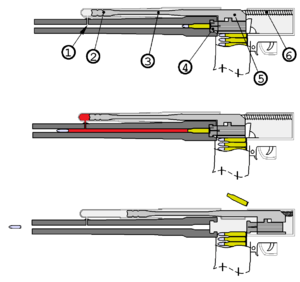
History
The first mention of using a gas piston in a single-shot breech-loading rifle comes from 1856, by the American Edward Lindner.[1] In 1866, Englishman William Curtis filed the first patent on a gas-operated repeating rifle, but subsequently failed to develop that idea further.[2] Between 1883 and 1885, Hiram Maxim filed a number of patents on blowback-, recoil-, and gas-operation. In 1889, the Austro-Hungarian Adolf Odkolek von Ujezda filed a patent for the first successful gas-operated machine gun.[3]
Gas systems
Most current gas systems employ some type of piston. The face of the piston is acted upon by combustion gas from a port in the barrel or a trap at the muzzle. Early guns, such as Browning's "flapper" prototype, the Bang rifle, and Garand rifle, used relatively low-pressure gas from at or near the muzzle. This, combined with larger operating parts, reduced the strain on the mechanism. To simplify and lighten the firearm, gas from nearer the chamber needed to be used. This high-pressure gas has sufficient force to destroy a firearm unless it is regulated somehow. Most gas-operated firearms rely on tuning the gas port size, mass of operating parts, and spring pressures to function. Several other methods are employed to regulate the energy. The M1 carbine incorporates a very short piston, or "tappet." This movement is closely restricted by a shoulder recess. This mechanism inherently limits the amount of gas taken from the barrel. The M14 rifle and M60 GPMG use the White expansion and cutoff system to stop (cut off) gas from entering the cylinder once the piston has traveled a short distance.[4] Most systems, however, vent excess gas into the atmosphere through slots, holes, or ports.
Gas trap
A gas trap system involves "trapping" combustion gas as it leaves the muzzle. This gas impinges on a surface that converts the energy to motion that, in turn cycles the action of the firearm. Hiram Maxim patented a muzzle-cup system in 1884 described in U.S. Patent 319,596 though it is unknown if this firearm was ever prototyped. John Browning used gas trapped at the muzzle to operate a "flapper" in the earliest prototype gas-operated firearm described in U.S. Patent 471,782. The Danish Bang rifle used a muzzle cup blown forward by muzzle gas to operate the action through transfer bars and leverage. Other gas-trap rifles were early production M1 Garands and German Gewehr 41 (both Walther and Mauser models). These systems are longer, heavier, dirtier and more complex than later gas-operated firearms. Despite these disadvantages, they used relatively low pressure gas and did not require a hole in the barrel. The American and German governments both had requirements that their guns operated without a hole being drilled in the barrel. Both governments would first adopt weapons and later abandon the concept. Most earlier US M1 Garand rifles were retrofitted with long-stroke gas pistons, making the surviving gas trap rifles valuable in the collector's market.
Long-stroke piston
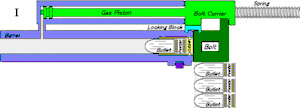
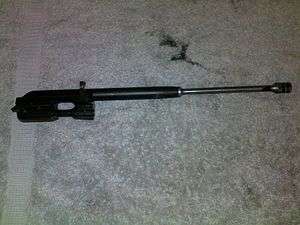
With a long-stroke system, the piston is mechanically fixed to the bolt group and moves through the entire operating cycle. This system is used in weapons such as the Bren light machine gun, AK-47, Tavor, FN Minimi, M249 Squad Automatic Weapon, FN MAG, FN FNC, and M1 Garand. The primary advantage of the long-stroke system is that the mass of the piston rod adds to the momentum of the bolt carrier enabling more positive extraction, ejection, chambering, and locking. The primary disadvantage to this system is the disruption of the point of aim due to several factors such as: the center of mass changing during the action cycle, abrupt stops at the beginning and end of bolt carrier travel, and the use of the barrel as a fulcrum to drive the bolt back. Also, due to the greater mass of moving parts, more gas is required to operate the system that, in turn, requires larger operating parts.
Short-stroke piston
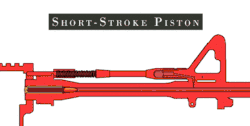

With a short-stroke or tappet system, the piston moves separately from the bolt group. It may directly push[5] the bolt group parts, as in the M1 carbine, or operate through a connecting rod or assembly, as in the Armalite AR-18 or the SKS. In either case, the energy is imparted in a short, abrupt push and the motion of the gas piston is then arrested allowing the bolt carrier assembly to continue through the operating cycle through kinetic energy. This has the advantage of reducing the total mass of recoiling parts compared with a long-stroke piston. This, in turn, enables better control of the weapon due to less mass needing to be stopped at either end of the bolt carrier travel. This design is available both on the civilian and military markets as retrofit to the AR15 family of weapons for addressing the perceived shortcomings of the Stoner gas system.
Direct impingement
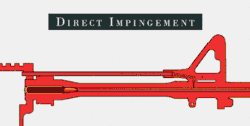
The direct impingement (DI) method of operation vents gas from partway down the barrel through a tube to the working parts of a rifle where they directly impinge on the bolt carrier. This results in a simpler, lighter mechanism. Firearms that use this system include the French MAS-40 from 1940, the Swedish Ag m/42 from 1942. The gas system of the American M16 series and M4 utilizes a gas tube to directly impinge the bolt carrier, while the USMC's M27 is based on the piston-driven H&K 416. One principal advantage is that the moving parts are placed in-line with the bore meaning that sight picture is not disturbed as much. This offers a particular advantage for fully automatic mechanisms. It has the disadvantage of the propellant gas (and the accompanying fouling) being blown directly into the action parts.[6] DI operation increases the amount of heat that is deposited in the receiver while firing, which can burn off and cover up lubricants. The bolt, extractor, ejector, pins, and springs are also heated by the same high-temperature gas. These combined factors reduce service life of these parts, reliability, and mean time between failures.[7]
Gas assist systems
Muzzle booster
The French Chauchat, German MG-42 machine gun, the British Vickers machine gun, and some other recoil operated firearms use a gas trap style mechanism to provide additional energy to 'boost' the energy provided by recoil. This "boost" provides higher rates of fire and/or more reliable operation. It is alternately called a gas assist, and may also be found in some types of blank-firing adapters.
Floating chamber
Early machine guns were expensive to operate. The United States Army wanted to train machine gun crews with less-expensive ammunition. To do this, they needed the .22 LR cartridge to operate firearms designed to use the .30-06 cartridge. David Marshall Williams invented a method that involved a separate floating chamber that acted as a gas piston with combustion gas impinging directly on the front of the floating chamber.[8] The .22 caliber Colt Service Ace conversion kit for the .45 caliber M1911 pistol also used Williams' system, which allows a much heavier slide than other conversions operating on the unaugmented blowback mechanism and makes training with the converted pistol realistic. A floating chamber provides additional force to operate the heavier slide, providing a felt recoil level similar to that of a full power cartridge.[9]
Gas-delayed blowback
The bolt is not locked but is pushed rearward by the expanding propellant gases as in other blowback-based designs. However, propellant gases are vented from the barrel into a cylinder with a piston that delays the opening of the bolt. It is used by Volkssturmgewehr 1-5 rifle, the Heckler & Koch P7, Steyr GB and Walther CCP pistols.
Gas ejection
Patented by August Schüler, the Reform pistol featured a vertical row of barrels that advanced upwards with each shot exposing the fired chamber. As the lower barrel fired, a gas hole between the barrels pressurized the empty barrel enough to eject the case rearward. An extended spur on the hammer prevented the spent case from hitting the firer in the face. The final case required manual extraction.
See also
- Recoil operation
- Blowback operation
- Blow forward
References
- Woodcroft, Bennet (1859). "Abridgments of the Specifications Relating to Fire-arms and Other Weapons, Ammunition, and Accoutrements: A.D. 1588-1858]-Pt. II. A.D. 1858-1866". Great Britain Patent Office.
- "The Curtis Rifle – the First Repeating Bullpup". August 10, 2018.
- Walter, John (November 28, 2019). Hotchkiss Machine Guns: From Verdun to Iwo Jima. ISBN 9781472836151.
- U.S. Patent 1,907,163
- U.S. Patent 2,090,656 Page 8, column 2, lines 67–70, Pg 9, column 1, lines 22–39
- Smith, W.H.B.; Ezell, E. C. (1983), Small Arms of the World, 12th Edition, Stackpole Company, Harrisburg PA
- Major Thomas P. Ehrhart Increasing Small Arms Lethality in Afghanistan: Taking Back the Infantry Half-Kilometer. US Army. 2009
- Charles E. Petty, "Delightful diversion: testing Kimber's new rimfire was a tough job, but someone had to do it", Guns Magazine, March 2004. Contains some discussion about the floating chamber device.
- S. P. Fjestad (1991). Blue Book of Gun Values (13th ed.). p. 291. ISBN 0-9625943-4-2.